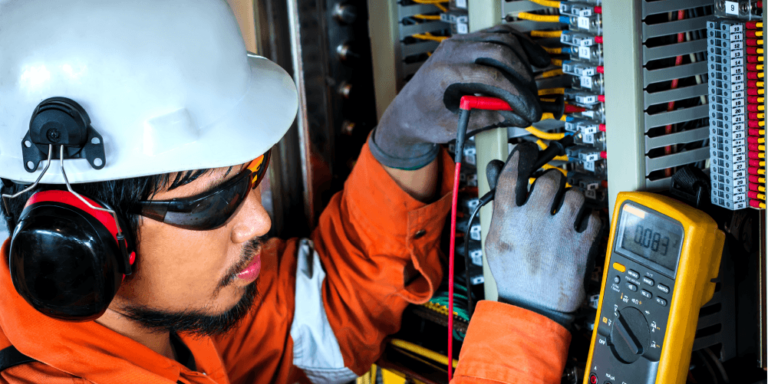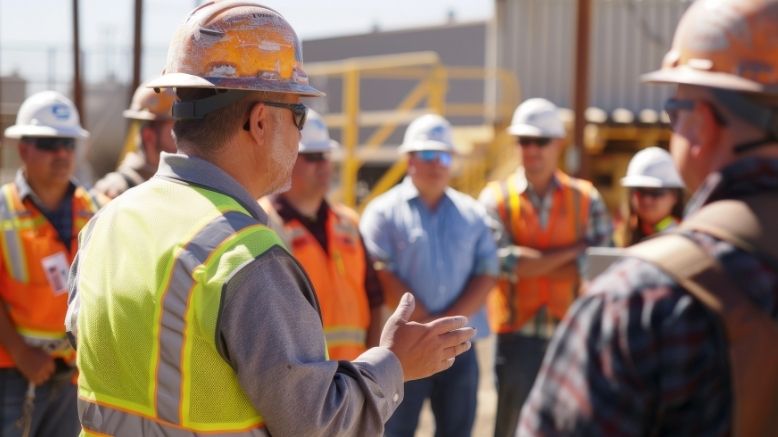— 11 min read
Electrical Hazards in Construction: How to Make Jobsites Safer


Last Updated Sep 1, 2024

Bob Hanes
Founder
15 articles
Bob Hanes is a professional writer and entrepreneur. He previously worked as a military sales and applications engineer for an aerospace firm, and cofounded a biotech company that creates drug screening solutions for the pharmaceutical industry. Bob has an MBA from the University of Buffalo in Logistics, Materials, and Supply Chain Management, and a BE in Mechanical Engineering. He is an avid Buffalo Bills fan.

Anthresia McWashington
Content Manager
20 articles
Anthresia McWashington is a Content Manager at Procore. She previously worked as an editor and reporter for Gulf Energy Information and Houston Media Group. She earned her BA in Communications and Journalism from the University of Houston. Anthresia loves track & field and practicing her French. She lives in Houston.

Justin Bogoyevac
Justin Bogoyevac brings 11 years of prior experience working as a Safety Specialist for an electrical subcontractor, and an EHS Specialist at Amazon to his role as Global EHS Specialist role at Procore. Additionally, Justin proudly served 10 years as a U.S. Army combat medic, completing two tours in Afghanistan. His expertise in OSHA and industry standards was developed through various positions in federal, general industry, and construction safety. Justin holds an M.S. in Emergency Services Management from Columbia Southern University.
Last Updated Sep 1, 2024

Electrical hazards present a huge opportunity for construction companies to use technology to improve worker safety. Although they are one of the most common hazards in construction, there are several strategies construction companies can implement to improve worker safety with electrical hazards.
Predictive safety management software is a tool that can help address the risks electrical workers face on the job site. Digital tools, reports, and logs can help project stakeholders keep track of hazards and get ahead of any future incidents in real time.
Since electrocution is one of the leading causes of fatalities in construction, accounting for about 8% of construction deaths in 2021, it’s important for construction companies to take the necessary precautions and create a safer working environment for themselves and their colleagues.
Table of contents
What are some common electrical hazards in construction?
Electrical hazards are a significant concern for construction workers, particularly electricians who frequently work with electrical equipment and installations. These hazards can lead to serious injuries or even fatalities. Understanding the electrical hazards in construction can help ensure worker safety. OSHA has identified the primary types of electrocution hazards that affect construction workers.
- Contact with power lines: Overhead and underground power lines can pose a significant risk to construction workers. Accidental contact with these lines can result in serious injury or death. Workers should always maintain a safe distance from power lines and be aware of their locations on the job site.
- Contact with energized sources: Exposure to energized electrical components, such as wiring, transformers, or circuit breakers, can lead to electrocution. Workers should use appropriate safety equipment and procedures — such as lockout/tagout — to ensure they are not working on energized equipment.
- Improper use of extension cords and electrical equipment: Damaged cords, missing ground prongs, or using cords that are not rated for the required voltage can create electrical hazards. Regular inspection and maintenance of electrical equipment and cords can help prevent accidents.
- Inadequate grounding: Proper grounding of electrical systems helps protect workers from electrical shock by providing a safe path for excess electricity to flow. An improperly grounded system can cause electrical currents to flow through a worker's body, leading to injury or death.
In addition to these hazards, electricians in construction may encounter specific risks, such as:
Working on energized equipment
Because safety personnel generally do not have the credentials to complete work on energized equipment, it’s important for them to work in lockstep with licensed electricians, such as an electrical superintendent, to develop a plan to de-energize equipment. The best practice is to take a pause in the work until these plans are established. Once proper procedures are in place, equipment testing should be done to ensure it is de-energized and safe to work on.
Safety directors or managers should follow the approved method of procedure (MOP) or step-by-step checklist created with the help of authorized electrical professionals, and act as an advisor during this process.
Courses about construction.
For construction.
Unlock your career potential with our free educational courses on Health & Safety, Data in Construction, and more.
Confined spaces
Electricians often work in confined spaces (such as underground vaults), presenting unique hazards. These can include cave-ins, limited access and egress, and the potential for water accumulation. Employers should train all workers in confined space safety procedures, including information on the roles and responsibilities while work is being conducted in these spaces, to help minimize these risks and ensure they use appropriate equipment.
Struck-by accidents
Electricians working alongside roadways or high-traffic areas are at risk of being struck by vehicles, especially when working at night. Wearing reflective vests and implementing proper traffic control measures are crucial to reducing these risks.
Leveraging safety management software can improve electrical safety on jobsites
Using technology that can pull data from various sources like IoT sensors, weather data, and construction site activities provides a proactive approach to identifying potential risks.
With safety management software like Procore’s Quality and Safety technology, project stakeholders and safety personnel are able to identify risks in real time, analyze site conditions, and use historical data to forecast potential incidents on the jobsite.
For example, the software can monitor electrical equipment and identify potential hazards — such as frayed cords, overloaded circuits, or damaged insulation — before they cause an accident. It can also create an electronic record of equipment inspections and maintenance, reducing the risk of oversight or missed steps.
Safety management software can also provide alerts to project managers or safety personnel when work is being performed in hazardous weather conditions or in the presence of flammable materials, helping to prevent accidents caused by environmental factors.
Previous incidents or hazards that have occured on a jobsite can be managed digitally with safety software, providing insight to project stakeholders when creating site specific safety plans or planning future projects.
By leveraging data from various sources, such as equipment sensors, worker activity, and even weather forecasts, safety management software can identify potential hazards and provide early warnings to both workers and managers.
6 ways to keep workers safe from electrical hazards
The NIOSH FACE Program provides investigative reports on fatal electrical incidents, which can help shed some light on the causes of these hazards. Some common factors in these incidents include inadequate worker training, lack of proper safety equipment, and failure to follow safety procedures.
Implementing safety measures — such as proper training, equipment maintenance, and adherence to safety procedures — can significantly reduce the likelihood of electrical accidents on the job site.
Below are some strategies to protect workers from electrical hazards on the job:
Wearing proper personal protective equipment (PPE)
Wearing the appropriate personal protective equipment is a crucial aspect of electrical safety on construction sites. It is essential to ensure that PPE is suited for the specific task at hand, well-maintained, and fits correctly. Reviewing arc flash labels or NFPA 70E standards for guidelines is helpful when selecting the appropriate PPE for the job.
According to OSHA, common types of PPE when working on or near electrical hazards may include:
- Insulated gloves: Properly rated voltage-level gloves can help protect workers from electrical shock and burns. Regularly inspect gloves for tears or punctures that may compromise their insulating properties.
- Safety glasses: Safety glasses protect your eyes from flying debris, sparks, and other hazards while working on electrical systems. Ensure that your safety glasses meet the appropriate American National Standards Institute (ANSI) standards and fit securely.
- Hard hats: Hard hats should be non-conductive and rated for electrical work. Regularly inspect hard hats for cracks or damage that could compromise their protective capabilities.
- Non-conductive footwear: Electrically insulated boots or shoes can help prevent electrical shock by reducing the flow of electricity through the body.
- Flame-resistant clothing: Wearing flame-resistant clothing can protect against arc flash incidents and reduce the severity of burn injuries.
PPE should be well-maintained and in good condition. Damaged, worn-out, or ill-fitting equipment could increase risk of worker injury. To maximize the effectiveness of their PPE, employers should be sure workers are trained on the correct use, care, and inspection of their protective equipment.
Learn more: An Electrician's Guide to PPE on the Jobsite
Comprehensive training is essential for all workers
Training should not be limited to journeymen and experienced workers. All workers on the construction site — particularly new and young employees — should receive comprehensive training on electrical safety and potential hazards. When everyone on the job site understands the risks and knows how to work safely, you create a culture of safety that benefits all trades and reduces the likelihood of accidents. This training should cover:
- Electrical safety procedures: Workers must understand the principles of electricity and the dangers associated with working on electrical systems. This includes recognizing potential hazards, such as exposed wiring, overloaded circuits, and damaged equipment.
- Hazard identification: Training should emphasize the importance of identifying and reporting electrical hazards, including the proper use of warning signs and barricades.
- Risk assessment: Teach workers how to assess the risks associated with electrical work and implement appropriate control measures, such as lockout/tagout procedures or the use of insulated tools.
- Proper use of tools and equipment: To ensure the proper use and maintenance of electrical tools and equipment, employers should train workers to understand their limitations and potential hazards. Additionally, workers should know how to use and inspect tools properly, and be aware of how they can prevent injuries from occurring. Insulated tools, for example, may help reduce the risk of an arc flash.
- Emergency response: Confirm that workers are familiar with emergency procedures, including how to respond to electrical fires, injuries, and other incidents. Site-specific safety plans (SSSP) provide a framework for identifying and mitigating electrical, and other, hazards that could occur on-site. SSSP's should be reviewed, updated, and communicated to workers to further ensure worker safety.
Employers should conduct training and update it as necessary to account for changes in technology, equipment, and industry standards to keep workers properly informed.
Additionally, continuing education training such as Procore’s Safety Qualified course, provides training on jobsite safety and mental well-being for workers.
Toolbox talks
Toolbox talks are an effective way to communicate safety information to the entire team. These brief meetings should cover various topics, including electrical safety, hazard recognition, and best practices. By discussing these topics regularly, you can reinforce safe work habits and promote a culture of safety on the jobsite. Toolbox talks can also serve as an opportunity for workers to share their experiences and lessons learned, helping the team to benefit from their collective knowledge.
To make toolbox talks more effective:
- Keep them short and focused: Aim for 10–15 minutes in length, and focus on a single topic to maintain workers' attention.
- Encourage participation: Ask open-ended questions and encourage workers to share their experiences, concerns, and ideas for improving safety.
- Use visual aids: Use diagrams, photographs, or props to help illustrate key points and enhance understanding.
- Schedule talks regularly: Conduct toolbox talks at least weekly to keep safety at the forefront of workers' minds.
Effective safety plans/procedures
Developing and implementing a comprehensive safety plan can help prevent electrical hazards on the job site. Key components of an effective safety plan include:
- Procedures for identifying and mitigating electrical risks: Establish guidelines for conducting risk assessments, selecting appropriate PPE, and implementing control measures to minimize electrical hazards.
- Emergency response protocols: Develop clear procedures for responding to electrical incidents, such as fires, injuries, or equipment malfunctions. This should include information on evacuations, first aid, and notifying emergency services.
- Regular safety audits and inspections: Conduct periodic audits and inspections to identify areas for improvement and ensure that safety procedures remain effective. Encourage workers to report any potential hazards or concerns they encounter on the job site.
- Incident reporting and investigation: Establish a process for reporting and investigating electrical incidents to identify root causes and implement corrective actions to prevent future occurrences.
Workers should be familiar with the safety plan and trained on how to follow its procedures consistently. Regular safety audits and inspections can help identify areas for improvement and ensure that safety procedures remain effective.
Lockout/tagout procedures
Lockout/tagout procedures involve de-energizing equipment and using locks and tags to prevent unauthorized re-energizing during maintenance or repair work. Workers should always test their equipment on a known power source before and after using it in the planned scope of work. This ensures the accuracy and reliability of the equipment and reduces the risk of working on energized systems.
These procedures involve:
- De-energizing equipment: Turn off the power source and disconnect it from the equipment to eliminate the risk of electrical shock.
- Physically locking the power source: Use lockout devices to prevent accidental re-energizing of the equipment during maintenance or repair.
- Tagging the equipment: To inform others that the equipment is undergoing maintenance and should not be operated, someone should attach a tag to the locked-out equipment.
Following lockout/tagout procedures, workers can significantly reduce the risk of electrical injuries occurring onsite. Companies should establish a lockout/tagout program that includes equipment-specific procedures and periodic inspections to ensure compliance.
One Line Documents
One Line Documents are diagrams that show the flow of energy throughout a building. Posting these documents in common areas for visibility gives workers a reference of which areas are energized and enables them to check them throughout the day as needed.
To ensure that One Line Documents are up to date with any changes made to the electrical system or new equipment installations, company leadership (including superintendents, foremen, and safety personnel) should regularly review and amend them with current information.
The construction industry presents numerous electrical hazards that can result in serious injuries or even fatalities. To mitigate these risks, it is essential to establish a strong safety culture within the company, emphasizing the importance of proper training, personal protective equipment, and adherence to safety procedures. By implementing comprehensive safety plans, conducting regular training sessions, and utilizing toolbox talks, construction workers can significantly reduce the likelihood of electrical incidents on the job site.
Moreover, maintaining visibility and accessibility to safety plan documents, such as incident reports, daily logs, and site-specific safety plans, is critical for promoting a safe working environment. Implementing construction software such as Procore’s daily log tool can help streamline data archiving and project tracking, giving project stakeholders updated information regarding safety protocols onsite.
Prioritizing safety and taking a proactive approach to address electrical hazards helps construction companies protect their workforce and create a safer, more productive working environment for all.
Was this article helpful?
Thank you for your submission.
100%
0%
You voted that this article was . Was this a mistake? If so, change your vote
Scroll less, learn more about construction.
Subscribe to The Blueprint, Procore’s construction newsletter, to get content from industry experts delivered straight to your inbox.
By clicking this button, you agree to our Privacy Notice and Terms of Service.
Thank you!
You’re signed up to receive The Blueprint newsletter from Procore. You can unsubscribe at any time.
Categories:
Written by

Bob Hanes
Founder | Resonant Lab
15 articles
Bob Hanes is a professional writer and entrepreneur. He previously worked as a military sales and applications engineer for an aerospace firm, and cofounded a biotech company that creates drug screening solutions for the pharmaceutical industry. Bob has an MBA from the University of Buffalo in Logistics, Materials, and Supply Chain Management, and a BE in Mechanical Engineering. He is an avid Buffalo Bills fan.
View profile
Anthresia McWashington
Content Manager | Procore
20 articles
Anthresia McWashington is a Content Manager at Procore. She previously worked as an editor and reporter for Gulf Energy Information and Houston Media Group. She earned her BA in Communications and Journalism from the University of Houston. Anthresia loves track & field and practicing her French. She lives in Houston.
View profileReviewed by

Justin Bogoyevac
Justin Bogoyevac brings 11 years of prior experience working as a Safety Specialist for an electrical subcontractor, and an EHS Specialist at Amazon to his role as Global EHS Specialist role at Procore. Additionally, Justin proudly served 10 years as a U.S. Army combat medic, completing two tours in Afghanistan. His expertise in OSHA and industry standards was developed through various positions in federal, general industry, and construction safety. Justin holds an M.S. in Emergency Services Management from Columbia Southern University.
Explore more helpful resources

Avoiding The App Trap: Overcome Financial Silos to Connect Field & Office
For general contractors working on razor-thin margins, rework and project delays are more than simple inefficiencies — they are major threats to the bottom line. For years, GCs have attempted...

Profit from Predictability: Construction Software as a Business Strategy
For general contractors, managing complex, multi-million-dollar projects, every project phase — from planning and budgeting to on-site execution — is an opportunity to lose time and money. Construction software is...

Defending Against Financial & Legal Risks on Megaprojects
The construction industry has seen marked growth in megaprojects. Some experts classify any project over $500 million as a megaproject, while others argue that the build needs to be $1...

Unlocking Project Intelligence: Moving from Raw Data to Actionable Insights
The construction industry faces a wide range of challenges, from ongoing labor shortages to frequent cost overruns. But some the biggest hurdles all stem from unpredictability. The general contractors (GCs)...
Free Tools
Calculators
Use our calculators to estimate the cost of construction materials for your next project.
Templates
Find a template to help you with your construction project tasks.
Material Price Tracker
Get the latest U.S. retail prices and view historical trends for common building materials.
Glossary
Explore key terms and phrases used in the industry.
